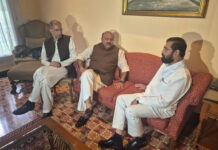History is replete with instances where Governors failed to adhere to the principles of the Bommai judgement and the Supreme Court had to intervene to uphold the Constitution
Despite several judicial pronouncements and recommendations of Justice RS Sarkaria and Justice Punchhi Commissions, Governors are known to have acted differently in seemingly similar situations with Constitutional consequences. Ultimately, it has been left to the Supreme Court to restore balance and uphold the principles enshrined in our Constitution.
According to the 38th Constitutional amendment of 1975, presidential proclamations issued under Article 356 were beyond the scope of any judicial review. This was later revoked by the 44th amendment of 1978. The Bommai judgement of 1994 not only laid down the principles to be followed in a Constitutional crisis — in the context of Article 356 — but also held that if the proclamation was invalidated, then notwithstanding its approval by Parliament, the court could lawfully revive the dissolved Legislative Assembly. Some of the cases, which illustrate the role of the Governor taking recourse to Article 356 and where the apex court had to intervene, have been discussed here.
In 1991, a peculiar situation had arisen in Meghalaya where the Speaker himself, with the help of the principal Opposition party, became a chief ministerial candidate. Earlier, he had disqualified five independent MLAs who had been supporting the Government, thereby precipitating a crisis. The Supreme Court intervened on a petition by the MLAs and gave an interim stay against the order of the Speaker, who then issued a Press statement to the effect that he did not accept any interference in his orders.
On a contempt petition being moved, the apex court ordered that all authorities of the State, including the Governor, must ensure that its earlier orders are implemented. The subsequent proceedings of the House showing a tie, the Speaker voted against the Government and adjourned the House sine die. It was discovered that the Speaker had not counted the votes of the Independents while declaring a tie. As such, the House continued the proceedings under a freshly elected Speaker and conveyed to the Governor that the House had confidence in the Government and had passed a motion of no confidence against the Speaker. Not paying any heed to the direction of the Supreme Court, the Governor observed that the matter was between the Supreme Court and the Speaker and recommended to the President dissolution of the House, which was so proclaimed under Article 356.
This matter came up to the Supreme Court, which in its orders stated: “The unflattering episode shows in unmistakable terms the Governor’s unnecessary anxiety to dismiss the Ministry and dissolve the Assembly and also his failure as a Constitutional functionary to realise the binding legal consequences of, and giving effect to the order of this court. What is worse, the Union Council of Ministers also chose to give advice to the President to issue the proclamation on the material in question. Prima facie, the material before the President was not only irrational but motivated by factual and legal mala fides. The proclamation was, therefore, invalid.”
Since fresh elections had been held to the Assembly and a new House had come into existence, the court did not issue the writ and direction for the restoration of the Lyngdoh Ministry or the Assembly.
Yet another case where the Governor’s action drew the public’s as well as the judiciary’s ire was from the State of Uttar Pradesh. As a former diplomat, the Governor had earlier held several important assignments. While the details of the case would be of immense interest to the reader, let me first quote the Supreme Court’s ruling in the matter:
“It appears that the Governor had proceeded on the basis of such information, intimation, letters or telephone calls. Nowhere has he mentioned that he had verified the issues himself before coming to any conclusion. His assessment was based on the intimation given to him by leaders of some of the political parties.”
The most interesting part of the events was that the Kalyan Singh Ministry was dismissed on February 21, 1998, just a few hours before the Lok Sabha elections were to be held. In the meantime, a petition was moved in the Allahabad High Court before the swearing-in of the successor Government. The proceedings in the High Court were taken up the same evening itself and continued till the next morning. In between, the Governor swore in Jagdambika Pal as the Chief Minister on the night of February 21 at 10 pm. The new Chief Minister was asked to seek a vote of confidence on February 24 but on August 22 itself, the High Court stayed the dismissal of the Kalyan Singh Government. This in effect meant that Jagdambika Pal could remain the Chief Minister for a few hours.
The matter went up to the Supreme Court, where Jagdambika Pal appealed against the stay on the dismissal of Kalyan Singh. Unprecedented in the judicial as well as legislative history, the top court fixed the time for the Assembly to meet on February 26 for a composite test. The order was unique as it was for the first time that the apex court was not only actively participating and facilitating a democratic processes but was also fixing the agenda for the legislature. The extracts from the historic order of the Supreme Court are reproduced here :
“(i) A special session of the Uttar Pradesh Assembly be summoned/convened for February, 26, 1998, the session commencing forenoon. (ii) The only agenda in the Assembly would be to have a composite floor-test between the contending parties in order to see which out of the two contesting claimants of chief ministership has majority in the House. (iii) It is pertinently emphasised that the proceedings in the Assembly shall be totally peaceful and disturbance, if any, caused therein would be viewed seriously. (iv) The result of the composite floor-test would be announced by the Speaker faithfully and truthfully.
Further, “It appears that he (the Governor) had sought to find out himself about the loss of confidence on the basis of information, as mentioned in his order, from the leaders of some groups or parties and had calculated himself to come to the conclusion that Jagdambika Pal had mustered support of the majority.” He had also mentioned that “it was not for me to do the count of heads. I have to go by what the leaders of the political parties maintained.”
According to him, no opportunity to Kalyan Singh to test his strength on the floor should be given. The reason for such a decision was sought to be supported on the ground that there was chance of horse-trading on the basis of his experience of what had happened in October, 1997. He also recorded that he received telephone calls from some people, who had informed that they were on their way to Lucknow from different places. He also mentioned that he wished to adhere to the principles of floor-test, “the essence of Bommai judgement.” In fact, this reference to the Bommai judgement was completely misplaced.
Further, according to the Supreme Court, “prima facie, it appears that the decision is based on materials, which in our view, cannot form materials for the Governor to form such an opinion. It is such a serious and a touchy issue and in such a hot haste on the eve of Lok Sabha election scheduled to be held on February 22, 1998, a few hours later, it cannot be ruled out that power has been exercised for purpose not warranted by law.”
As ordered by the Supreme Court, a composite floor-test was undertaken in the Uttar Pradesh Assembly where Kalyan Singh carried the day. Thereafter, within a few days, the Governor submitted his resignation, which was just a few months before his tenure was to come to an end.
In yet another case in Uttarakhand, the Governor had fixed the date for the Chief Minister to seek a vote of confidence but a day before it, the Assembly was suspended under Article 356. The suspension was overruled by the High Court and when the matter went up to the Supreme Court, a date for a floor-test and the modalities for conducting the same were assigned. The law and judicial secretary of the Government was entrusted the task of overseeing the process of voting where the sitting Government won the confidence of the House. Here also, the date for the Assembly to be convened and the agenda for its proceedings was fixed by the Supreme Court.
In the case of Arunachal Pradesh, in a landmark judgement, the Supreme Court led by Chief Justice of India, Justice Khehar, along with Justice Misra and Justice Madan Lokur, restored the status quo of the Assembly as prior to the declaration of President’s Rule. The Governor’s decision to advance the Session from January, 14, 2016, to December 16, 2015, was quashed as also the President’s Rule. This also led to the resignation of the Governor and restoration of the Nabam Tuki Government.
It would not be out of place to mention that in the four cases discussed above, one Governor was a politician and the other three were from the IAS, IPS and IFS. From time to time, instances have come to notice where the principles laid in the Bommai judgement have not been followed by Governors and as such, wherever and whenever warranted, despite the provisions of Article 212, where courts are not to enquire into proceedings of the legislature, the Supreme Court has assumed a proactive role to ensure the majesty of the Constitution.
(The writer is a former Governor and a Senior Advisor at the Pranab Mukherjee Foundation)





























